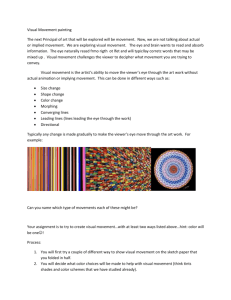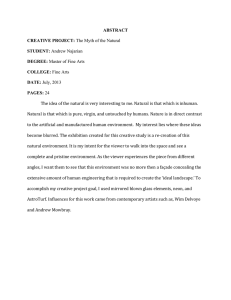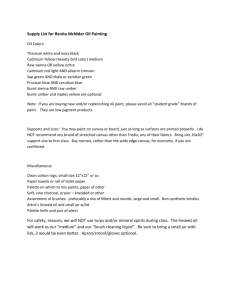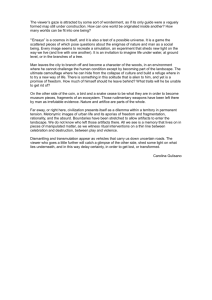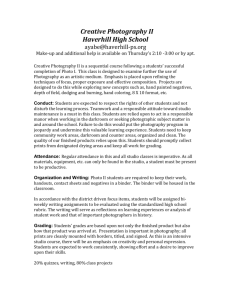Document 11139424
advertisement
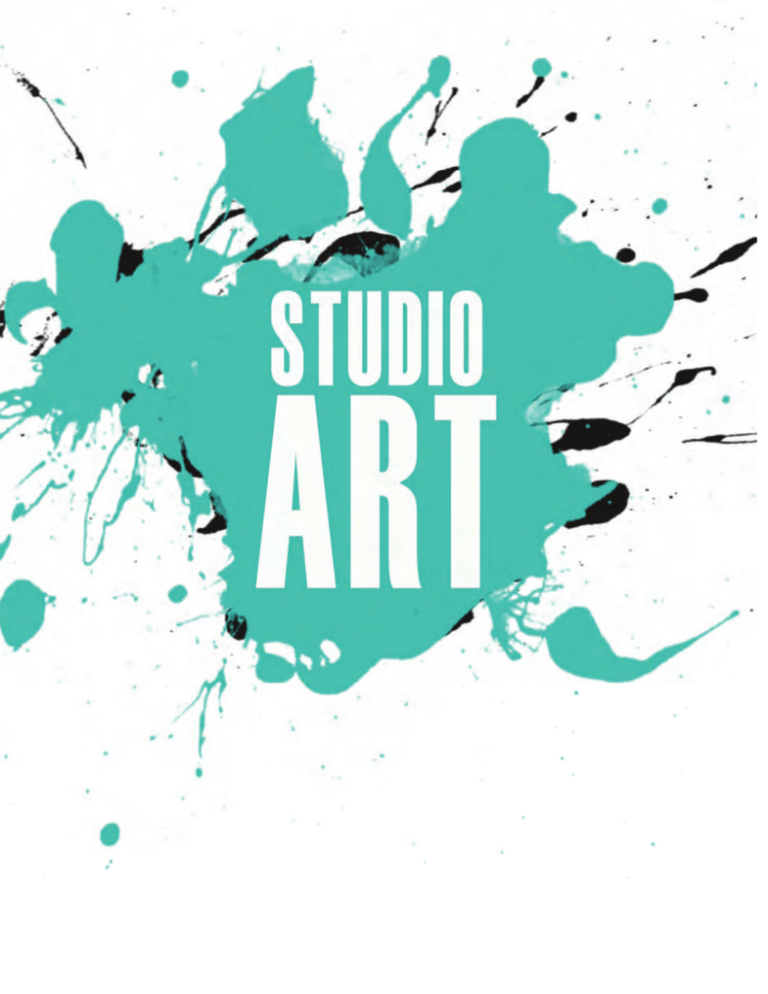
Class of 2013 The works in this exhibition and catalogue were done by Boston College studio majors during their senior year. The Senior Project is much more than a requirement that must be fulfilled in order to graduate. It represents a significant step in the difficult transition from student to young artist. The twelve artists in this class of 2013 struggled long and hard with their ideas, emotions, work habits, technical issues, and budgets to bring into focus and give visual life to their very different visions of what art and the world look like. The exhibited work is a representative selection made from the huge number of works produced by these students during the past year. The Senior Project is much like a guided independent study. Students are expected to produce a body of work that investigates, in depth, an idea or set of concerns that are meaningful to them. They consult with many of the studio and art history faculty, from whom they receive periodic critiques of their work, and meet regularly with a member of the studio faculty who serves as the coordinator. As the faculty member fortunate enough to work with these young artists, I have had the pleasure to see not only the development of their work, but their growth as people. There is nothing quite like the bond that forms between a person and their work when it gives rise to a new identity. I never tire of bearing witness to that quiet miracle. I wish to thank you for the opportunity and applaud your achievements. As a young girl, I always dreamed of seeing the world; yet, as I began to accomplish this, I realized places weren’t as I saw them in books and movies. Yes, Paris had the Eiffel Tower and the Arc of Triomphe, but there was so much more to the city than the romantic feeling and the majesty of strolling down “Champs Elysees”. As my senior project, I decided to use design and digital media to emphasize this contrast of expectation and reality. I was able to achieve so in two ways. The first was by doing a book that showed the difference of how people think places are and how they actually are. I was able to show this contrast by using eight of the top cities of the world. I combined slogans from travel literature and appropriated photographs into collages. On the right side of the book, these collages showed the “cliché” side of every city, and on the left side they showed images that suggested a more real vibe of how it feels to be there. At the same time, I inverted the images of the left side, so that the book could be seen from one perspective; and then, turned upside down, from a completely different one. The second was by doing a video of the city of Boston. I used simple photographs that I took myself from around the city to be able to show its different perspectives. People tend to think Boston is all about the beauty of the Charles River, the fans of the Red Sox, and the student life from all its colleges and universities. Driven to demonstrate the reality that there is more to Boston than what is initially thought, I made this video by contrasting “clichéd” imagery with “unusual” imagery, a technique that allowed me to compare the popular Boston to a more intimate Boston that is less present in the public’s imagination. Expectation Vs Reality, Video, 2013 Expectation Vs Reality, 13 x 11 in, Large Format Landscape book I believe artificial materials are connected to the natural world. Because the former is predominantly perceived as a byproduct of the latter, man-made materials are often considered to be inferior, and therefore, disconnected from nature. However, my work is an embodiment of a dialogue between these two worlds that demonstrates, through an exchange of equivalent forms, the two are inseparable. My interests and investigations into the properties of artificial materials develop the ways in which man-made materials can be shaped into work that references nature. Through refashioning and re-contextualizing artificial materials, I believe I have been able to reveal their oneness with nature. The conversation between the two can be seen in the transformations of artificial materials into their corresponding natural forms. I believe that since men are part of nature, the products of men are also nature’s products—both of which I find beautiful. Water Lilies, detail from installation 9’ x 9’, Aluminium Cans Raindrops, detail from installation 9’ x 9’ x 9’, Monofilament line, glue I am a person that cant help but slow down and study the people I meet. As an artist and a person, I create art as a way to affirm the old adage, “Don’t judge a book by its cover,” because people are much more than what we have the ability to see. When I look at the face, I am interested with what is beneath the surface and how these qualities inform what I see. My drawings deconstruct the face into pieces to show that we are similarly formed by a multitude of experiences and emotions that converge to create our unique selves. I feel sympathy with the works of Otto Dix. He ruthlessly depicted the brutality of war and its effect on its survivors. With the harsh mutilation and deformation of his various subjects, he too went beneath the surface to reveal the often decaying underlying pieces of war-torn men. I pick my subjects from people I know as well as complete strangers who I photograph and then draw. My art simply states: when you look at someone don’t just see them as a face, but as a person who has an intricate past and a complicated present. I end with a similar quote that seems apt to my work, “If you judge a book by it’s cover, you might miss out on an amazing story.” Its a Girl Problem, 8’’x11’’, Ink of paper, 2013 Drunkenly Broken, 8’’x11’’, Ink on paper, 2013 Unlike most of my generation, I do not express myself under false pretenses on Facebook, Twitter, and other forms of social media. I have a lip ring, a tattoo and multi-colored hair. I am a gamer and a hardcore one at that. I am an artist. I am addicted to smokeless tobacco. If you did not already know this, I want you to know. I am not afraid to express who I am. I am interested in addictions, self-isolation, and how people create “fairy tale” stories in order to hide their true selves from the public. Primarily, my work consists of narratives that are derived from my personal experiences. In this installation I draw attention to the issues surrounding addictions, specifically with smokeless tobacco, and how addictions lead to self-isolation. $9125.00 , 48 in x 96 in x 96, detail from installation, Snuff Cans, 2013 $9125.00, 48 in x 96 in x 96, skoal snuff cans table, 2013 This installation is about how we create, order, and relate to space. In various societies architectural structures often imply nuanced understandings of the cosmos’ relationship to human beings. We shape our context as much as it shapes us. Although I have given shape to this installation, the site has shaped itself in many ways. In my installation the competing levels and planes of the arrangement refer to the way we often build and compartmentalize our minds in order to organize, understand, and function in our world. The levels of expression emphasize the different states of physical space and mental space. Throughout the process of making this piece, I have been reflecting on the use of right angles and boxes versus curves and spheres. I think we simultaneously acknowledge our Earth as round while we live, speak, and build as if it were flat. Despite knowing the Earth rotates, we all still agree the sun will set tonight. The Earth is Still Flat, 5’ x 5’, Paper, 2013 The Earth is Still Flat, 2’ x 2’ x 2’, Ceramic, 2013 The content of dreams and their role in the human experience has long been a fascination of mine. From childhood on, my own dreams have frequently been marked by vivid and intense images. These images often include surreal landscapes, fantastical beasts, and extraordinary structures. The world of dreams and symbols has also intrigued me because of my Cherokee heritage, and I intend to explore Native American spiritual and symbolic interpretations of dreams as well through my dream pieces. The multidimensional and indistinct elements of dreams will be expressed through etching illusory dream images into contrasting hard, physical materials, such as sheets of aluminum and copper. I wish to exaggerate the contrast between the illusory world of dreams and the material world through the physicality of the work and call the viewers’ psychological, sentimental perceptions to the forefront through its emotional content. The final intention of my work is to integrate these diverse elements and engage the viewer in the raw, vulnerable emotional states often conjured by the unconscious mind. Wolf, 12 x 30”, Copper, 2013 Child, 30 x 12”, Aluminium, 2013 move·ment /’moøvmənt/ a. The act or an instance of moving; a change in place or position b. A series of actions and events taking place over a period of time and working to foster a principle c. To show marked activity; rouse up from inactivity d. A tendency or trend e. A self-contained section of an extended composition f. To carry on one’s life or activities in a specified environment g. A person’s location and activities during a specific time h. Abundance of events or incidents i. A series of actions directed or tending toward a particular end j. A series of organized activities working toward an objective k. To go or pass to another place or in a certain direction Untitled, 25 x 56, Digital Photography, 2013 Untitled, 16 x 20”, DigitalPhotography, 2013 My intention is to create a navigable constellation of possibilities within a painting. I would like to produce a space in which spectators can find their own point of entry, so that they may develop their own narrative (much like choose your own book ending, yet within a painting). I derive my sources from what some would already constitute as abstract sources. Untitled, Oil on canvas, 2013 Untitled, Oil on canvas, 2013 Untitled, Oil on canvas, 2013 I am fascinated with the idea of engaging in the imagination and telling visual narratives that reflect realms of fantasy and escapism. My approach combines traditional and modern forms of art making by juxtaposing the “abstract” qualities of paint against the specificity of photo-based images. This series is profoundly influenced by the hand-clapping and jump rope games that I played as a child and my mature love for surrealism, contemporary culture, and art. Over the years, I have been envious of the pure, illogical sense of creativity that children exhibit as they learn to make sense of the world and have been pushing myself to reconnect with that way of thinking. By negotiating between sensory overload and suggestion, I aim to create a psychological space that taps into one’s emotions and subconscious memory. Domestic Dispute, 24” x 40”, Mixed Media, 2013 Frankenlove, 24” x 40”, Mixed Media, 2013 My current body of work explores the concept of bodily barriers through installations that use a variety of materials; yarn, fabric, string, found objects. The works are installed in doorways, real life passages, which reference the varying permeable points of the body. I seek to produce objects/ installations that relate to or respond to a site. Site specificity allows the objects to be integrated into non-art settings with a physical and immediate presence. However, regulation, politics, and management often precede its introduction into the outside world. For me, this is part of artistic process and is integral in moving my pieces from conception to reality. Driven by both concept and material, I make art to create stimulating experiences that cause the viewer to question motive and meaning. As a maker, a creator, I engage in practices of handcraft that then translate as such to the audience of my pieces, through both visual and haptic means. This nostalgia of the homespun slows the viewer into truly perceiving and questioning, rather than merely seeing and registering. Often painfully meticulous and labor intensive, my work pays homage to the artist’s time spent, which can tend to go unnoticed. I MAKE art with my HANDS (and usually a glue gun). Womb, 7 x 3 ft, Yarn and wooden dowel, 2013 Veins (detail), 7 x 3 ft, Polyurethane Clear Tubing, Food coloring, Wooden dowel, 2013 Whether I work in photography, dance, painting or design I sense my presence in all of work. I photograph the human body. The body affords me the opportunity to explore different formal issues. I’m aware that the body can speak to many issues (eroticism, athleticism, etc.) but my concerns are very formal. Everything is done in the studio; I spend a great deal of time setting up my models in order to create beautiful and unusual forms. I love the formal clarity I can achieve by using a solid black or white background. The controlled lighting and simple uninterrupted ground make for dramatic images. The near life-size scale increases their physical presence. I prefer the intimacy of working with people I know rather than professional models. Their willingness to accommodate my artistic needs infuses the formal with something more personal. These friends have allowed my skills and passion to grow. Skin, 48 x 24”, Photography, 2013 Skin, 36 x 36”, Photography, 2013 A portrait expresses not only a person’s physical image, but also hopefully a deeper insight into their character and their context. When creating the portraits of these children, I tried to think about identity as it is held by the subject, and also identity as it is seen by the outside world: their self versus their “label.” The juxtaposition of childhood innocence and the harsh realities that young people often face became the connecting subject matter between each piece. In this artwork I make use of the simplicity of black and white to emphasize the figure and it’s body language; it’s expression. I also considered scale as a means of connecting with the viewer. The bold statement of black and white, often on a large scale, adds a sense of drama. I would hope that this work serves testimony to the strength and resilience of these individuals. Harrold, 42x47 in, Graphite on paper, 2013 Kevin, 17x22 in, Graphite on paper, 2013 Class of 2013 Welcome to the 2013 “Senior Selections” Exhibition! The minor in Studio Art at Boston College provides students with the opportunity to integrate creative and artistic practice with other academic or research pursuits. The program, which focuses on the individual’s development of visual literacy, imaginative thinking, and technical skills, reflects the ability of studio art to be an important and integrating force in a liberal arts educations. Every year, our minors share their unique experiences and bodies of knowledge from other disciplines to bear in the studio and gallery. The work in this year’s exhibition is presented in many media, and clearly reflects interests and methodologies which have been informed by studies in psychology, economics, education, English, biology, theology, and art history. The sheer diversity of subject areas and material approaches speaks eloquently to Boston College’s commitment to educate the individual as a whole person. It has been my great pleasure to direct the 2013 Art Minors Exhibition. The culmination of an intense course is this exhibition of work. This manifestation of countless hours of studio work, discourse, reflection, and revisions. I thank the students for allowing me to act as their mentor. Your commitment to a life of productive, reflective creativity is a continual source of reinspiration for your artist-teachers. My work investigates the formation of female identity between adolescence and young adulthood. Specifically, I am interested in how females project themselves onto fictional characters and landscapes, thereby willing a partial separation from reality. For my project, I chose a cast of three young women who have experienced a slippage between fiction and reality: my childhood friend, my sister, and myself. Within the imaginative landscape of the developing female, this installation of paintings and objects vacillates between whimsical notions of childhood and the darker realms of psychological and physical harm. Working in oil on canvas and mixed media, I seek to create a dialogue between image, object, and presentation that reflects the work’s thematic tension between fiction, reality, and interpretation. The works are deliberately theatrical, borrowing elements from the visual language of the stage in order to emphasize the fictionalization of identity and invite the viewer to construct a narrative from fragmented elements. La Petite Danseuse de Vingt et Un Ans, 24” x 30”, Oil on Canvas, 2013 The concept of the Seven Deadly Sins – Avarice, Gluttony, Lust, Wrath, Pride, Envy, and Sloth – is familiar to most and witnessed by all. Sin and injustice are endemic to all societies and permeate every social, political, and cultural boundary mankind has ever devised. Mortal vices and Hell-worthy “deal-breakers” with God encourage some to live more loving and righteous lives, brings others into compliance, or are ignored altogether. Self-obsession, a fundamental lack of empathy, and a subtly paralyzing sense of complacency separate us and sap the will to change our lives and the lives of those around us. In this series of images, each mortal sin is depicted as a creature within an environment that illustrates how sin is manifested in contemporary culture. I work with ink and watercolor to manipulate line quality and color to emphasize the intense subject matter and dark humor at play in these imagined scenarios. My work is greatly influenced by the art of Wayshak, Chet Zar, Jeff Soto, and Francisco Goya for their depiction of creatures and their emphasis on the grotesque and the underbelly of society. Avarice (detail) , 15” x 11”, Watercolor and Ink Everyday our faces are glued to some sort of screen. In this series, “Illuminated”, the subject of my work is Boston College students bathed in artificial light sources. I am inspired by the distinct visual style of film noir posters and cinematography, specifically how black and white images create contrast. I focus on individuals illuminated by unknown sources, which evoke the beauty and the ghastly quality of concentrated light and highlight the way it infiltrates the chosen composition. In Auto Brightness Off, a beautiful, delicate girl lies on an afghan, hands extended above her, as if reaching for the heavens. Her clear eyes gaze up meaningfully, as if memorized by the banal piece of technology in her hands. The beatific scene imparts a sense of mystery and awe, creating a tension between the visual enlightenment of the subjects and the menial reliance individuals have on ubiquitous technology. Sarah, 24” x 36”, Digital Photography, 2013 The university setting is a liminal state between nature and culture. This series of tablecloths explores etiquette, or lack thereof, of my college peers. Dinner with my roommates influenced my first tablecloth and gave me a launching point to engage with whatever manners survives four years of college and how much gets tossed aside. Once upon a time, forks were considered “prissy” and “against the design of God” because humans already had natural forks, better known as fingers. Maybe I’m now the prissy one, but the clank-nscrape of forks on teeth drives me insane. My obsessive attention to that sound gave me the idea for this project. I address the casualties of grammar and civility that occur within the university setting. Each tablecloth incorporates a repetitive, off-kilter, and mildly flippant tone into the content. These pieces serve as meditations that begin with my hyper attentiveness to female behaviors that define the transition from girl to woman. To achieve that, I look at my own upbringing and the mannerisms of BC girls. Over the course of three tablecloths, I work with bleach and dye, permanent marker, and various fabric textures. These materials help me explore the dichotomy between the untamed and the civilized that are at play during meals in college. Bite-N-Scrape (detail), 90” diameter, Polyester, Sharpie and Dye, 2013 My work explores the relationship between the outward appearance of composure and the inner turmoil that often accompanies difficult life events. I am drawn to stoneware clay because of its inherent physicality and its close relationship with the hand of the creator. By making ornately decorative ceramic vessels and then inflicting some sort of violence upon them, I want to evoke a broken wholeness, an image of the walking wounded. In these pieces, beauty and femininity fuse with trauma and fragility to suggest emotional conflict and the inescapable hurt of the human condition. While each piece will remain marked by its trauma, it still maintains its functionality and beauty. My series attempts to capture this human capacity to transcend darkness and show the resilience and transformation that occurs with every struggle. Convallaria majalis, 12” x 6” x 6”, LNB, Stoneware Clay, 2013 Rachel, 20x30 inches, Digital Photography, 2013 This series of work explores my generation’s preoccupation and obsession with digital media. I love technology, but am afraid of its addictive control. With equal parts love and disgust, I am driven to create images which explore its powerful presence in our lives. I work with digital photography, computer graphics programs, and gaming technology because, as I see it, they are the three main instigators of my suitemates and my own obsessive tendencies. Our relationship to media, and how we consume it, affects our bodies on a conscious and unconscious level. My work is both a critique and representation of media through media. Assuming the role of an invisible onlooker I attempt to capture my subjects’ engagement with gaming media. I have focused on Halo, a violent war game played on the TV through an Xbox 360 gaming console, because of its entrancing and overwhelming power to capture the attention of its players. Halo offers an exhilarating and visceral experience that evokes feelings of rage and joy within its players, often to the point where players assume a zombie-like state. I am creating work that explores the physicality of paint. I apply acrylic paint, spray paint, acrylic mediums and additives to nontraditional backgrounds such as particle board, which I find more liberating than traditional canvas. By using tools such as pallet knives and cake decorating tubes, as well as ubiquitous items such as string and tape, the surfaces of the paintings become three-dimensional topographies. I manipulate materials, textures, gestures, and layers until each painting expresses a movement, a verb, and an emotion. I try to work in collaboration with the nature of the materials to achieve visual harmony. My work is in dialogue with decollage and abstract expressionism, as well as modern painters and multi-media artists. The process of creating acts as my inspiration to continue creating, and informs my subsequent work. I want the viewer to have a visceral experience when contemplating my work, as if engulfed in the materiality of the piece. Richard Simmons(detail), 40x48”, Acrylic and mixed media on particle board I cut paper into lacy compositions into which are interwoven song lyrics, quotations, and images that inspire and describe me. I enjoy how by cutting paper I am capable of transforming a worthless material into a thing of value capable of expression. The lace highlights the tension between positive and negative spaces and challenges the viewer to engage in careful observation. Much like how love, heartbreak and change are woven together to create personal experiences, my pieces create a self-portrait where minute details make a whole. Each piece takes hours of obsessive cutting, a process, which is both relaxing and cathartic. I never know what the piece will look like until the very end and how all the pieces will fit together to reveal meaning. Katy Byrnes, Classics (detail), 18” x 28” Paper, 2013 In this series, I am exploring caffeine, alcohol, and drug addiction, all of which I have closely observed during my past four years at Boston College. By subverting well-known marketing graphics from the products that guide these addictions, my work aims to illuminate the powerful associations that are created through advertising. I use a variety of traditional and non-traditional techniques including digitally etched stencils, acrylics paint, spray paint, and found paper on wood. I am interested in captivating the emotional and physical effects of these addictions through the composition and style of each piece. The stenciled images featuring altered traditional logos are ironic and comical, but ultimately evoke a conversation about how branding and advertising can be just as strong and controlling as the addictions themselves. Caffeine (detail), 36x36”, Acrylic paint, spray paint, and found paper on wood, 2013 The Hillcrest Estate, 16” x 24”, paper collage, 2013 As the daughter of first generation Chinese immigrants, I have found myself split between the traditional Chinese culture of my parents and contemporary American culture. My project attempts to merge these two cultures and embrace my heritage through an exploration of landscape imagery that has featured prominently in my life: landscapes painted on traditional Chinese wall scrolls, the ancient architecture of China, and various suburban locations around the United States where I have lived. My work is engaged in a dialogue with traditional Chinese paper craft and the mola textile art form of the Kuna people of Panama and Colombia. I am fascinated with the reductive process of precisely cutting the paper and the additive process of laying the paper to form an image. I am most passionate about the detail-oriented precision needed to create the designs in paper. I work with bright, vibrant colors and landscape motifs in order to explore themes of reality and fantasy. In this series, I attempt to combine landscapes that sprout purely from my imagination with landscapes inspired by real locations, merging the two until they are undistinguishable from each other. I want the viewer to experience awe and confusion when they view my work, unable to distinguish what is real and what is imaginary. In the spring of 2012, I spent a semester living and studying in South Africa. The people I saw during my time there, as well as their lifestyles, had a major impact on me. I was deeply affected by how some of my preconceptions about South Africa were true and how other aspects of South African culture took me completely by surprise. This work is an examination of assumptions and stereotypes. In order to address the tensions between stereotypes and what I saw, I overlapped negatives of pictures that played opposite ideas against each other. These overlapping images were created solely in the darkroom. I believe that the use of photographic paper and chemicals displays more truth than digital technology, as it is more difficult to alter. The method of projecting two images at once through an enlarger embodies the heart of my series, layering two opposite ideas over each other to create a third meaning. Neighbour Goods Market, 24” x 30”, Photograph, 2013 My series of oil paintings explores issues of intimacy by focusing on the power of the nude human body to convey emotion. I am interested in both the relationship between the viewer and the subject as well as the relationship between the subjects themselves. I assume a voyeuristic role as I watch unknowing subjects engage in private moments. My work exposes the human form caught in intimate encounters. The canvas provides the opportunity to reveal questions of vulnerability, fear, and passion that compose the human condition. I invite the viewer to step out of our consumer-driven world and into a place where social constructs fall away, leaving only the body in its natural form. Oil paint allows for a sensuous engagement with human flesh. My painting approach is based in careful observation with a keen attention to detail. There is a tension between the analytical representation of the bodies and the raw emotion conveyed by their expressions. I ask viewers to empathize with these moments of intimacy that are so often concealed from the world. Untitled, 2013 My series of oil paintings explores issues of intimacy by focusing on the power of the nude human body to convey emotion. I am interested in both the relationship between the viewer and the subject as well as the relationship between the subjects themselves. I assume a voyeuristic role as I watch unknowing subjects engage in private moments. My work exposes the human form caught in intimate encounters. The canvas provides the opportunity to reveal questions of vulnerability, fear, and passion that compose the human condition. I invite the viewer to step out of our consumer-driven world and into a place where social constructs fall away, leaving only the body in its natural form. Oil paint allows for a sensuous engagement with human flesh. My painting approach is based in careful observation with a keen attention to detail. There is a tension between the analytical representation of the bodies and the raw emotion conveyed by their expressions. I ask viewers to empathize with these moments of intimacy that are so often concealed from the world. Molly, 18” x 18”, watercolor and blood, 2013 “Out of the huts of history’s shame I rise Up from a past that’s rooted in pain I rise I’m a black ocean, leaping and wide, Welling and swelling I bear in the tide. Leaving behind nights of terror and fear I rise Into a daybreak that’s wondrously clear I rise Bringing the gifts that my ancestors gave, I am the dream and the hope of the slave. I rise…” In a direct response to the last stanza of Maya Angelou’s Still I Rise, this series explores the relationship between bodily expression and cultural context. Using a 35mm film camera and printing on fiber paper, my African American male model portrays my personal take on what it means to embody “the dream and the hope of the slave” in this day and age. In investigating my interest in racial relation through a sociological lens this series explores the ways in which race impacts my own life. I want the viewer to experience a sense of tension between the subject and their environment. In an attempt to challenge the notion of breaking through history’s shame and pain, my subject experiences an environment that was once unknown to the slave. In this work in particular, I am using my own artistic form of expression to depict the ways other students of color have used their individual gifts to make sense of their identity at a predominately white university. Colby, 11” x 14”, Photograph, 2013 Classic literature, more often than not, was written by men about men and any women characters were weak and meant only to play damsels in distress or to serve as a love interest for the male. In my project I feature the strong women characters of classic literature. These characters include: Emma from Emma, Anne Frank from The Diary of Anne Frank, Scout from To Kill a Mockingbird, Jo from Little Women, and Hester from Scarlet Letter. For each character I create two pieces: a functional purse and a non-objective watercolor. Inspired by the work of the late innovative designer Alexander McQueen, known for his ability to make seemingly nonfunctional items purposeful. I am interested in exploring the symbolic significance of a woman’s purse as a secret vessel and a private space. Through my project I hope to expand our understanding of strong female characters by giving them non-linguistic methods of self-expression. Emma, 22x22, multimedia, 2013 Catalog Design by Lucia Mantica Photography by Jordan Ball To the Fine Arts Department, particularly Andrew Tavarelli & Sheilla Gallagher, the Office of the Dean of Arts and Sciences, and Joanne Elliot, Administrative Assistant, Fine Arts Department
